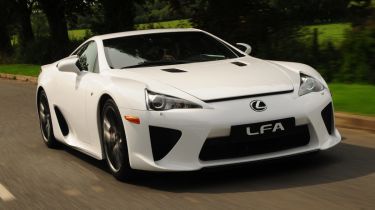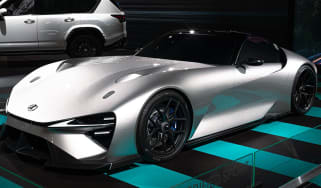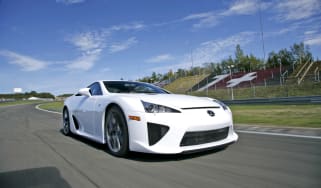Lexus LFA (2010-2012) review
The Lexus LFA is Toyota's showcase supercar, featuring carbon fibre construction, a raft of hi-tech kit and a bespoke V10 engine

The Lexus LFA is the first supercar from the firm, but it’s far from being a half-hearted plunge. It has the full technical might of Toyota behind it, and is a superbly engineered machine. The £345,000 LFA is limited to 500 cars, with an additional 50 cars gaining the £55,000 Nurburgring performance pack – which turns the already impressive standard model into a track-focused racer. The styling won't be to all tastes, but build quality is first-class – nothing less than you’d expect from something with such a hefty price tag – and performance from even the standard car will leave you breathless. If you want a car with more exclusivity than a Ferrari 458 Italia or Lamborghini Aventador, then the LF-A could be your trump card.
Engines, performance and drive
As you’d expect from a car that costs as much as two Mercedes SLS’s, performance is staggering. The 552bhp, 4.8-litre V10 can rev to its 9,000rpm redline as quickly as a superbike engine – there's a digital rev counter, because an analogue one simply couldn't keep up. The engine is mated to a six-speed automated manual that changes gear in just two-tenths of a second. When it comes to corners, the LFA is pretty handy, thanks to a multi-link rear suspension setup that was refined with extensive testing at the Nurburgring in Germany. And to cement its performance credentials Lexus offers the Nurburgring pack, which lowers and stiffens the suspension for even more focused handling. Both cars can sprint from 0-62mph in a staggering 3.7 seconds and hit a top speed of 202mph.
MPG, CO2 and Running Costs
The £300,000+ purchase price of the Lexus LFA is simply staggering. Initial predictions placed the Lexus supercar at Mercedes SLS money, but Toyota’s premium brand stunned the public by charging more than twice as much. That said, if you are the lucky owner of an LFA, the exclusivity alone should mean residuals are strong. However, be prepared to dig deep when it comes to servicing and running costs, as the Lexus’ mighty V10 is packed full of complicated technology. But then if you can afford an LFA, you can probably afford to keep it on the road, too.
Interior, design and technology
There's no denying the Lexus LFA has presence, but the looks won't be to all tastes. Even without the additional Nurburgring performance pack, the Japanese supercar looks as menacing as a Mercedes SLS or Ferrari 458. The gaping front vents give the car an aggressive face, and the huge wheelarches and squat stance mean there is no mistaking it for anything else. The low roofline sweeps seamlessly into a sharp rear end – where Lexus has arguably saved the best for last. The LFA has three exhaust pipes, set up in a triangular formation, sitting above the hefty F1-style rear diffuser. The Nurburgring edition adds orange paint and lashings of carbon fibre – including a massive rear wing. Inside, the dash is laced with leather and carbon fibre, and the electrically adjustable bucket seats hug perfectly, remaining totally supportive as the car is pushed to its limits.
Practicality, comfort and boot space
Practicality isn't a priority with a car like this. Although the LFA is front engined, space behind the seats is almost non-existent. Lift the tailgate and you’ll find only enough room for a small overnight bag, and the cubbyies in the cabin are genuinely tiny. In terms of every day usability, the Lexus is disadvantaged due to poor visibility – making driver and passenger almost totally unaware of where the car’s four corners lie.
Reliability and Safety
Lexus is renowned for building bulletproof cars. Year after year owners continually sing the praises of their cars and dealers in ownership surveys. Although the LFA costs four times as much as an LS 600h, it shouldn’t prove any more troublesome to own. In terms of safety, the LFA has huge brakes and is as dynamically accomplished as anything from Ferrari or Lamborghini, so keeping it in a straight line is perfectly achievable. That said, at low speeds the automated manual tends to slip, causing the V10 to spin the rear wheels with even the slightest blip of throttle.








